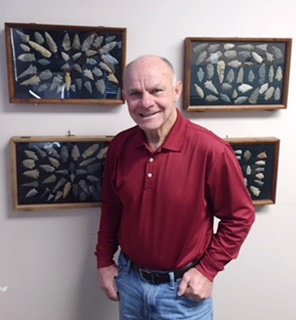Arrowhead hunting with Jackie Corbin
Jackie Corbin goes hunting for arrowheads almost every week. Corbin, an emeritus professor of molecular physiology and biophysics at Vanderbilt University, is sitting in his office as we chat on the phone, looking at the arrowheads he has found. He has four frames of them hanging on the wall, each with 25 to 30. “These are all of my best ones,” Corbin tells me proudly. “I show off.”  Corbin's office wall with arrohead display
Corbin's office wall with arrohead display
Corbin’s most recognized scientific contribution is his discovery and characterization of phosphodiesterase 5, PDE5, with his longtime collaborator Sharron Francis. PDE5 degrades the cyclic nucleotide second messenger cyclic guanosine monophosphate and is important in controlling blood flow. Their work became the basis for using inhibitors of PDE-5 to treat erectile dysfunction. The erectile dysfunction drugs available now, Viagra, Levitra and Cialis, are all PDE-5 inhibitors.
Corbin is regarded as the leading expert in the cyclic nucleotide field. Scientists come to Tennessee from across the country and around the world to visit him. “Many people would have questions about these,” Corbin says about his arrowhead points. “Where did you find them, how old they are, what kind of tribes – so we have many discussions about them.”
Corbin likes to give his visitors an arrowhead point in a small frame to take home. “It’s a local thing, and they can take away a Tennessee artifact,” he says. With each arrowhead frame, he includes a description of the arrowhead, what kind of point it is, and how it was made. “I hope they hang them up, but I don’t know what they do with them,” he says with a laugh. We talk more about his arrowhead hunting hobby. Our conversation has been edited for length and clarity.
So where do you go arrowhead hunting?
The best place to go is a plowed field after a rainstorm. I get permission from a farmer to look on his ground, and I sometimes spend a full day with that, walking the fields and looking on the surface. Don’t do any digging — that’s illegal, in fact. Just look on the surface. Now, in plowed fields, the problem is that many of the arrowheads are broken. They’re broken by the farm implements — plows and so forth. So on plowed fields, more than 90 percent of the arrowheads are broken. Sometimes it’s just a nick, but still broken.
The other place I hunt, where the arrowheads are not broken, is on river banks. The riverbanks get eroded, so the arrowheads get uncovered; and they’ve never been plowed, so they’re not broken by the implements. I have much better luck on riverbanks, but it’s much harder to find the arrowheads on riverbanks. There are weeds, poison ivy, chiggers, snakes — everything on the riverbank is rough.
It’s a great thrill to find even one in a day; it would be treasure.
How often do you find arrowheads?
I would say maybe, if I go all day, on average, I could find one complete point. There have been many times when I didn’t find any, of course, and sometimes I find three, but on average, I can find one complete point. I don’t count a broken one. I get a lot of enjoyment, and I sometimes take my students and postdocs with me and they really enjoy it too.
Can you identify the tribe that made an arrowhead?
Well, these are very old, starting about 13,000 years ago going up to 500 years ago or so. The tribes are only very recent. We recognize tribes only 500 years ago, maybe 1,000 years ago; 2,000 to 3,000 years ago on back, we don’t know much about tribes, so we refer to these arrowheads as being Paleolithic or Archaic or Mississippian. If I find a point, I would refer to it by saying, “Oh, that’s an Archaic point; it’s about 8,000 years old.” We have a catalog of the shapes and styles, so I can tell almost immediately how old it is and what era when I pick it up out of the field.
It’s interesting, because the best points are the oldest ones. You’d think it’d be the other way around – they’d have learned how to make them. But the best ones are the oldest ones, because those are the biggest ones. In the early days, from 13,000 to about 2,000 years ago, there were no bows and arrows. That was a late development. All the early ones are spears or knives, so they’re very big and very beautiful. From most of the fields where I look, the points are Paleolithic or Archaic; they’re at least 6,000 years old. I find very few real arrow points. They’re only 500 to 1,000 years old. You can tell because they are very small, and they are not as well made as the spear points and the knives.
How did you learn all this?
Mostly by reading and experience. I have some buddies that are very good too, and about once a year I go to a show and see what other collectors find. Often, they have a much better set than I do. Most collectors buy and sell them, but I don’t do that. I just find them and keep them. I don’t have a single one that I bought.
Early on, I made a rule that I was never going to buy one, because if I buy one, I’ll keep on buying more and that’s no fun. When I describe a point here on my wall to someone, I want it to be one that I found myself. Some people say, “I want to buy that point,” and I say, “Nope. I wouldn’t sell that for a million dollars.” That’s the truth. I wouldn’t sell for a million dollars. I worked so hard for these points. I wouldn’t sell any of them. I just keep them. I really show off.
Read about Jackie Corbin's recent "Reflections" article in the Journal of Biological Chemistry.
Enjoy reading ASBMB Today?
Become a member to receive the print edition four times a year and the digital edition monthly.
Learn moreGet the latest from ASBMB Today
Enter your email address, and we’ll send you a weekly email with recent articles, interviews and more.
Latest in Opinions
Opinions highlights or most popular articles

Sketching, scribbling and scicomm
Graduate student Ari Paiz describes how her love of science and art blend to make her an effective science communicator.

Embrace your neurodivergence and flourish in college
This guide offers practical advice on setting yourself up for success — learn how to leverage campus resources, work with professors and embrace your strengths.

Survival tools for a neurodivergent brain in academia
Working in academia is hard, and being neurodivergent makes it harder. Here are a few tools that may help, from a Ph.D. student with ADHD.

Hidden strengths of an autistic scientist
Navigating the world of scientific research as an autistic scientist comes with unique challenges —microaggressions, communication hurdles and the constant pressure to conform to social norms, postbaccalaureate student Taylor Stolberg writes.

Black excellence in biotech: Shaping the future of an industry
This Black History Month, we highlight the impact of DEI initiatives, trailblazing scientists and industry leaders working to create a more inclusive and scientific community. Discover how you can be part of the movement.

Attend ASBMB’s career and education fair
Attending the ASBMB career and education fair is a great way to explore new opportunities, make valuable connections and gain insights into potential career paths.

